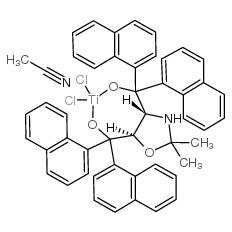197389-47-2
| 中文名 | (4R,5R)-(-)-2,2-Dimethyl-Alpha |
|---|---|
| 英文名 | acetonitrile,dichlorotitanium,[(4R,5R)-5-[hydroxy(dinaphthalen-1-yl)methyl]-2,2-dimethyl-1,3-oxazolidin-4-yl]-dinaphthalen-1-ylmethanol |
| 分子式 | C49H40Cl2N2O3Ti |
|---|---|
| 分子量 | 823.62600 |
| 精确质量 | 822.19000 |
| PSA | 63.51000 |
| LogP | 12.77940 |
| 储存条件 | 密封于阴凉干燥环境中 |
| 稳定性 | 遵照规定使用和储存则不会分解。 |
| 分子结构 | 1、摩尔折射率:无可用 2、 摩尔体积(cm3/mol):无可用 3、 等张比容(90.2K):无可用 4、 表面张力(dyne/cm):无可用 5、 极化率:无可用 |
| 更多 | 1. 性状:无可用 2. 密度(g/mL,25/4℃):无可用 3. 相对蒸汽密度(g/mL,空气=1):无可用 4. 熔点(ºC):无可用 5. 沸点(ºC,常压):无可用 6. 沸点(ºC,5.2kPa):无可用 7. 折射率:无可用 8. 闪点(ºC):无可用 9. 比旋光度(º):无可用 10. 自燃点或引燃温度(ºC):无可用 11. 蒸气压(kPa,25ºC):无可用 12. 饱和蒸气压(kPa,60ºC):无可用 13. 燃烧热(KJ/mol):无可用 14. 临界温度(ºC):无可用 15. 临界压力(KPa):无可用 16. 油水(辛醇/水)分配系数的对数值:无可用 17. 爆炸上限(%,V/V):无可用 18. 爆炸下限(%,V/V):无可用 19. 溶解性:无可用 |
|
Section 1: Product Identification (4R,5R)-(-)-2,2-Dimethyl-alpha,alpha,alpha',alpha'-tetra(1-naphthyl)-1,3-dioxolane-4,5-dimethanolatotitanium Chemical Name: (IV) dichloride acetonitrile adduct CAS Registry Number:197389-47-2 Formula:C47H36Cl2O4Ti EINECS Number:none
Chemical Family:organometallic complex Synonym:Titanium naphthylTADDOL Section 2: Composition and Information on Ingredients IngredientCAS NumberPercentACGIH (TWA)OSHA (PEL) Title compound197389-47-2100%no datano data Section 3: Hazards Identification Emergency Overview:Irritating to skin, eyes and respiratory tract. With moisture, may liberate fumes of hydrogen chloride. Primary Routes of Exposure:Inhalation, skin, eyes. Eye Contact:Dust and vapors cause moderate irritation of the eyes. Skin Contact:Causes moderate irritation of the skin. Inhalation:Inhalation of dust or fumes causes irritation to the nose, mucous membranes and respiratory tract. Ingestion:No information is available on the physiological effects of ingestion. Irritation to skin, eyes, mucous membranes and respiratory tract. Exposure to moisture slowly produces Acute Health Affects: hydrochloric acid. Chronic Health Affects:No information available on long-term chronic effects. NTP:No IARC:No OSHA:No SECTION 4: First Aid Measures Immediately flush the eyes with copious amounts of water for at least 10-15 minutes. A victim may need Eye Exposure: assistance in keeping their eye lids open. Get immediate medical attention. Wash the affected area with water. Remove contaminated clothes if necessary. Seek medical assistance if Skin Exposure: irritation persists. Remove the victim to fresh air. Closely monitor the victim for signs of respiratory problems, such as difficulty Inhalation: in breathing, coughing, wheezing, or pain. In such cases seek immediate medical assistance. Seek medical attention immediately. Keep the victim calm. Give the victim water (only if conscious). Induce Ingestion: vomiting only if directed by medical personnel. SECTION 5: Fire Fighting Measures Flash Point:none Autoignition Temperature:none Explosion Limits:none Extinguishing Medium:carbon dioxide, dry powder or foam If involved in a fire, fire fighters should be equipped with a NIOSH approved positive pressure self-contained Special Fire Fighting Procedures: breathing apparatus and full protective clothing. Hazardous Combustion andIf involved in a fire this material may emit toxic fumes. Decomposion Products: Unusual Fire or Explosion Hazards: No unusual fire or explosion hazards. SECTION 6: Accidental Release Measures Spill and Leak Procedures:Small spills can be mixed with vermiculite or sodium carbonate and swept up. SECTION 7: Handling and Storage Store material in a tightly sealed bottle, preferably under an inert atmosphere. If possible, handle material in an Handling and Storage: efficient fume hood. Prolonged exposure to the atmosphere will lead to degradation of the product. SECTION 8: Exposure Controls and Personal Protection Eye Protection:Always wear approved safety glasses when handling a chemical substance in the laboratory. Skin Protection:Wear protective gloves. Ventilation:If possible, handle the material in an efficient fume hood. No respirator is required when handling this material unless large volumes are handled in a poorly ventilated Respirator: area. Ventilation:If possible, handle the material in an efficient fume hood. Additional Protection:No additional protection required. SECTION 9: Physical and Chemical Properties Color and Form:Yellow powder Molecular Weight:783.58(824.63) Melting Point:no data Boiling Point:decomposes Vapor Pressure:no data Specific Gravity:no data Odor:may have an acidic odor. Solubility in Water:reacts with water SECTION 10: Stability and Reactivity Stability:Moisture-sensitive solid Hazardous Polymerization:none Conditions to Avoid:material may absorb water from the atmosphere on prolonged exposure. Incompatibility:water, alcohols, reactive metals Decomposition Products:Carbon dioxide, carbon monoxide, hydrogen chloride, titanium oxide, and organic vapors. SECTION 11: Toxicological Information RTECS Data:No specific information available from the RTECS files. Carcinogenic Effects:No data available Mutagenic Effects:No data available Tetratogenic Effects:No data available SECTION 12: Ecological Information Ecological Information:No information available SECTION 13: Disposal Considerations Disposal:Dispose of according to local, state and federal regulations. SECTION 14: Transportation Shipping Name (CFR):Non hazardous Hazard Class (CFR):NA Additional Hazard Class (CFR):NA Packaging Group (CFR):NA UN ID Number (CFR):NA Shipping Name (IATA):Non hazardous Hazard Class (IATA):NA Additional Hazard Class (IATA):NA Packaging Group (IATA):NA UN ID Number (IATA):NA SECTION 15: Regulatory Information TSCA:not listed in the TSCA inventory SARA (Title 313):not reportable under SARA Title 13 Second Ingredient:none SECTION 16 - ADDITIONAL INFORMATION N/A |
|
生态学数据: 该物质对环境可能有危害,对水体应给予特别注意。
|
| 风险声明 (欧洲) | 20/21/22-36/37/38 |
|---|---|
| 安全声明 (欧洲) | 26-36/37/39 |


